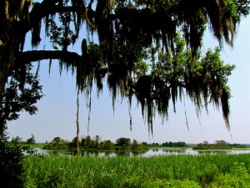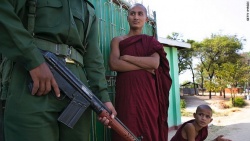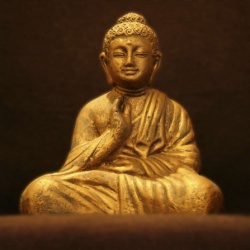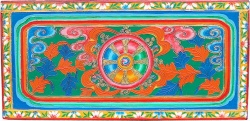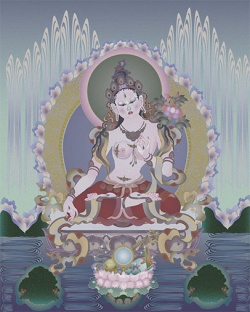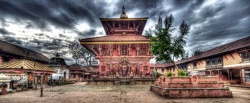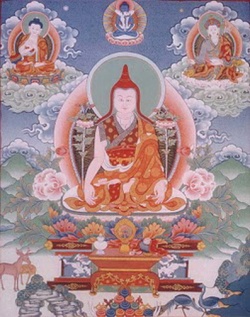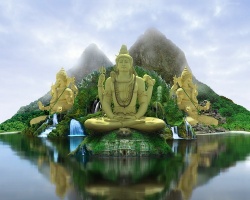Difference between revisions of "Tibet (Great Empires)"
(Created page with " <poem> Tibet, officially the {{Wiki|Tibetan Empire}}, is a large {{Wiki|nation}} situated in the Himalayas, the Tibetan plateau and its surroundings. The full of...") |
|||
| Line 1: | Line 1: | ||
| − | + | {{DisplayImages|2593|2425|1822|947|1275|1319|2723|361|273|1446}} | |
<poem> | <poem> | ||
| − | [[Tibet]], officially the {{Wiki|Tibetan Empire}}, is a large {{Wiki|nation}} situated in the [[Himalayas]], the [[Tibetan]] plateau and its surroundings. The full official [[name]] of [[Tibet]] is "The [[Sacred | + | [[Tibet]], officially the {{Wiki|Tibetan Empire}}, is a large {{Wiki|nation}} situated in the [[Himalayas]], the [[Tibetan]] plateau and its surroundings. The full official [[name]] of [[Tibet]] is "The [[Sacred and Buddhist Nation of the Tibetan Empire]]". A common [[name]] is "[[Empire of Tibet]]", "{{Wiki|Tibetan Empire}}" or simply [[Tibet]]. |
| − | [[Songtsen Gampo]] was the son of [[Namri Songtsen]], [[king]] of [[Lhasa]]. When his father [[died]] Songten assumed the [[throne]] at the age of 13. He started with the expansion of his {{Wiki|kingdom}} outside of [[Lhasa]], conquering [[Kham]], [[Ü-Tsang]] and [[Amdo]]. He started the construction of the [[Potala Palace]] and the [[Jokhang Monastery]]. He also | + | [[Songtsen Gampo]] was the son of [[Namri Songtsen]], [[king]] of [[Lhasa]]. When his father [[died]] Songten assumed the [[throne]] at the age of 13. He started with the expansion of his {{Wiki|kingdom}} outside of [[Lhasa]], conquering [[Kham]], [[Ü-Tsang]] and [[Amdo]]. He started the construction of the [[Potala Palace]] and the [[Jokhang Monastery]]. He also conquered the {{Wiki|Kingdom}} of [[Zhang Zhung]]. [[Wikipedia:Emperor Taizong of Tang|Emperor Taizong]] of Tang was expanding his [[empire]] into {{Wiki|Central Asia}} and demanded tribute from [[Tibet]], but that was a serious mistake. [[Songtsen Gampo]] refused and prepared a surprise attack, besieging {{Wiki|Chang'an}} and successfully capturing [[Taizong]] to personally demand tribute. When he wished to marry a {{Wiki|Chinese}} {{Wiki|princess}}, [[Wikipedia:Emperor Taizong of Tang|Emperor Taizong]] agreed in exchange for keeping {{Wiki|Chang'an}}. With the {{Wiki|Tang Dynasty}} greatly weakened nothing could stop the rise of his [[empire]], but he [[died]] in 649, leaving the [[throne]] to his son [[Gungsrong Gungtsen]]. |
| − | |||
| − | conquered the {{Wiki|Kingdom}} of [[Zhang Zhung]]. [[Wikipedia:Emperor Taizong of Tang|Emperor Taizong]] of Tang was expanding his [[empire]] into {{Wiki|Central Asia}} and demanded tribute from [[Tibet]], but that was a serious mistake. Songtsen | ||
Expansion | Expansion | ||
| − | Gungsrong only reigned for five years, he did not had the [[ambition]] to expand his [[empire]], when he [[died]] his son [[Mangsong Mangtsen]] succeeded him. [[Mangsong Mangtsen]] expanded the [[empire]] into [[Bhutan]] and [[Nepal]], but [[died]] when leading a campaign against the [[Pala]] [[Empire]]. His wife, Khri ma lod became {{Wiki|empress}} regent with her son Tridu Songtsen as puppet [[emperor]]. She had great [[ambitions]] and started the conquest of {{Wiki|Bengal}}, [[Arakan]], [[Nanzhao]] and the {{Wiki|Tarim Basin}}. This eventually resulted in a [[war]] with {{Wiki|Empress Wu}} Zetian, who had seized the [[throne]] of [[China]] and established the Second {{Wiki|Zhou Dynasty}}. {{Wiki|Empress}} Khri led the attack on {{Wiki|Chengdu}} which was unsuccessful, {{Wiki|Empress Wu}} [[realized]] that there was no need for [[war]], she proposed a [[peace]] treaty in which [[Tibet]] would hold its holding in the [[Tibet]] and [[Nanzhao]], but [[China]] would hold the {{Wiki|Tarim Basin}}. {{Wiki|Empress Wu}} [[died]] in 705, she appointed {{Wiki|Princess}} Taiping as her successor, but her brother {{Wiki|Prince}} Li Xian held {{Wiki|de facto}} power, but was an ineffective [[ruler]]. {{Wiki|Empress}} Khri ma lod attacked the weakened {{Wiki|Zhou Dynasty}} and conquered {{Wiki|Chengdu}} and {{Wiki|Chang'an}}, renaming it She on. Khri ma lod [[died]] in 712, her son [[Me Agtsom]] succeeded her. [[Me Agtsom]] conquered Tajikistan and Kyrgyzstan from the Abbasid {{Wiki|Caliphate}}. | + | [[Gungsrong]] only reigned for five years, he did not had the [[ambition]] to expand his [[empire]], when he [[died]] his son [[Mangsong Mangtsen]] succeeded him. [[Mangsong Mangtsen]] expanded the [[empire]] into [[Bhutan]] and [[Nepal]], but [[died]] when leading a campaign against the [[Pala]] [[Empire]]. His wife, [[Khri ma lod]] became {{Wiki|empress}} regent with her son [[Tridu Songtsen]] as puppet [[emperor]]. She had great [[ambitions]] and started the conquest of {{Wiki|Bengal}}, [[Arakan]], [[Nanzhao]] and the {{Wiki|Tarim Basin}}. This eventually resulted in a [[war]] with {{Wiki|Empress Wu}} Zetian, who had seized the [[throne]] of [[China]] and established the Second {{Wiki|Zhou Dynasty}}. {{Wiki|Empress}} [[Khri]] led the attack on {{Wiki|Chengdu}} which was unsuccessful, {{Wiki|Empress Wu}} [[realized]] that there was no need for [[war]], she proposed a [[peace]] treaty in which [[Tibet]] would hold its holding in the [[Tibet]] and [[Nanzhao]], but [[China]] would hold the {{Wiki|Tarim Basin}}. {{Wiki|Empress Wu}} [[died]] in 705, she appointed {{Wiki|Princess}} [[Taiping]] as her successor, but her brother {{Wiki|Prince}} Li Xian held {{Wiki|de facto}} power, but was an ineffective [[ruler]]. {{Wiki|Empress}} [[Khri ma lod]] attacked the weakened {{Wiki|Zhou Dynasty}} and conquered {{Wiki|Chengdu}} and {{Wiki|Chang'an}}, renaming it She on. [[Khri ma lod]] [[died]] in 712, her son [[Me Agtsom]] succeeded her. [[Me Agtsom]] conquered [[Tajikistan]] and [[Kyrgyzstan]] from the Abbasid {{Wiki|Caliphate}}. |
Stagnation | Stagnation | ||
| Line 17: | Line 15: | ||
ResurgenceE | ResurgenceE | ||
| − | The [[empire]] was at the verge of civil [[war]] when [[Langdarma]] [[died]], leaving the [[throne]] vacant. His sons were all competing for the [[throne]]. One of his daughters, Yangchen, had a [[vision]] of [[Buddha]], who told her to spread [[Buddhism]] to all of the [[world]] and bring [[peace]] and [[prosperity]]. Yangchen was determined to eliminate the opposition, she banished her brothers and sisters to [[India]] and changed the law so that women could become {{Wiki|Empress}} regnant of [[Tibet]]. In 842 she was crowned {{Wiki|Empress}} regnant of the {{Wiki|Tibetan Empire}}. She reorganized the [[empire]] and brought order. She was [[selfish]] and {{Wiki|cruel}} during her early reign. She attacked [[Emperor]] [[Devapala]] of the [[Pala]] [[Empire]] and vassalized it. She also conquered parts of [[Kazakhstan]], Northern [[China]], [[Mongolia]], {{Wiki|Afghanistan}} and {{Wiki|Pakistan}} and treated the subjugated [[people]] harsh. She also claimed that she was [[Buddha]] and she claimed the Mandate of [[Heaven]]. During her middle reign there was a large rebellion who wanted to bring down the regime. The rebellion escalated and reached [[Lhasa]], the [[Potala Palace]] was set on [[fire]] and [[relics]] were destroyed. {{Wiki|Empress}} Yangchen ordered her armies to brutally slay the revolt! Tens of thousands were killed and Yangchen had an epiphany [[realized]] that she was a {{Wiki|cruel}} [[person]] and she killed many innocent [[people]]. She changed her ideals and she started a new {{Wiki|era}} of [[peace]]. She changed the constitution and gave all [[people]] {{Wiki|equal}} rights, freedom of {{Wiki|speech}} and [[religion]]. Although she had not become a pacifist, she always gave [[peaceful]] negotiations the priority. She built numerous [[monasteries]], [[temples]] and reconstructed the [[Potala Palace]]. She encouraged {{Wiki|artists}} and [[scientists]] to live in the {{Wiki|capital city}} of [[Lhasa]] and started a golden age for the {{Wiki|Tibetan Empire}}. [[Lhasa]] had become the largest city on [[earth]] by 882 with more then one million inhabitants. The power and influence of [[Tibet]] reached far continents and some leaders such as Simeon I, Al-Mutawakkil, Pope Agatho and Indravarman I even met Yangchen and visited [[Lhasa]]. She also started trade with {{Wiki|Europe}} with the [[Silk Road]]. {{Wiki|Empress}} Yangchen the Great abdicated in 882 in favor of her son | + | The [[empire]] was at the verge of civil [[war]] when [[Langdarma]] [[died]], leaving the [[throne]] vacant. His sons were all competing for the [[throne]]. One of his daughters, Yangchen, had a [[vision]] of [[Buddha]], who told her to spread [[Buddhism]] to all of the [[world]] and bring [[peace]] and [[prosperity]]. Yangchen was determined to eliminate the opposition, she banished her brothers and sisters to [[India]] and changed the law so that women could become {{Wiki|Empress}} regnant of [[Tibet]]. In 842 she was crowned {{Wiki|Empress}} regnant of the {{Wiki|Tibetan Empire}}. She reorganized the [[empire]] and brought order. She was [[selfish]] and {{Wiki|cruel}} during her early reign. She attacked [[Emperor]] [[Devapala]] of the [[Pala]] [[Empire]] and vassalized it. She also conquered parts of [[Kazakhstan]], Northern [[China]], [[Mongolia]], {{Wiki|Afghanistan}} and {{Wiki|Pakistan}} and treated the subjugated [[people]] harsh. |
| + | |||
| + | She also claimed that she was [[Buddha]] and she claimed the Mandate of [[Heaven]]. During her middle reign there was a large rebellion who wanted to bring down the regime. The rebellion escalated and reached [[Lhasa]], the [[Potala Palace]] was set on [[fire]] and [[relics]] were destroyed. {{Wiki|Empress}} [[Yangchen]] ordered her armies to brutally slay the revolt! Tens of thousands were killed and [[Yangchen]] had an epiphany [[realized]] that she was a {{Wiki|cruel}} [[person]] and she killed many innocent [[people]]. She changed her ideals and she started a new {{Wiki|era}} of [[peace]]. She changed the constitution and gave all [[people]] {{Wiki|equal}} rights, freedom of {{Wiki|speech}} and [[religion]]. Although she had not become a pacifist, she always gave [[peaceful]] negotiations the priority. | ||
| + | |||
| + | She built numerous [[monasteries]], [[temples]] and reconstructed the [[Potala Palace]]. She encouraged {{Wiki|artists}} and [[scientists]] to live in the {{Wiki|capital city}} of [[Lhasa]] and started a golden age for the {{Wiki|Tibetan Empire}}. [[Lhasa]] had become the largest city on [[earth]] by 882 with more then one million inhabitants. The power and influence of [[Tibet]] reached far continents and some leaders such as Simeon I, Al-Mutawakkil, Pope Agatho and Indravarman I even met Yangchen and visited [[Lhasa]]. She also started trade with {{Wiki|Europe}} with the [[Silk Road]]. {{Wiki|Empress}} [[Yangchen]] the Great abdicated in 882 in favor of her son [[Tenzin Gampo Yarlung]]. | ||
Period of [[Peace]] | Period of [[Peace]] | ||
| Line 25: | Line 27: | ||
{{Wiki|Mongol}} Invasions | {{Wiki|Mongol}} Invasions | ||
| − | In 1206 {{Wiki|Temujin}} was declared {{Wiki|Genghis Khan}} and founded the [[Mongol Empire]]. He rapidly conquered the Jin [[Empire]], {{Wiki|Zhou Dynasty}} and Khwarezmid [[Empire]]. He demanded tribute from them, but the then [[emperor]] [[Sangye | + | In 1206 {{Wiki|Temujin}} was declared {{Wiki|Genghis Khan}} and founded the [[Mongol Empire]]. He rapidly conquered the [[Jin]] [[Empire]], {{Wiki|Zhou Dynasty}} and [[Khwarezmid]] [[Empire]]. He demanded tribute from them, but the then [[emperor]] [[Sangye Gampo]] refused. In 1210 {{Wiki|Genghis Khan}} invaded [[Tibet]] and captured She on and [[wikipedia:Kashgar|Kashgar]], then he besieged the Great City of [[Lhasa]] for more then ten months, he broke through the city walls and ravaged the city,killing thousands,before he stormed the [[Potala Palace]]. He faced the [[emperor]] himself, but the [[emperor]] was a formidable sword fighter himself and the [[emperor]] killed him by stabbing him. Without a leader the {{Wiki|Mongol}} troops were quickly defeated and the {{Wiki|Mongols}} surrendered and made [[peace]]. {{Wiki|Ögedei Khan}} was plotting revenge on the [[emperor]] for killing his father and [[gathered]] an enormous army,but he [[died]] in a campaign against the [[Abbasid]] {{Wiki|Caliphate}} in 1241. [[Töregene Khatun]] became regent and Great [[Khatun]] and started the invasion,which was successful and she killed [[Sangye Gampo]], annexing the {{Wiki|Tibetan Empire}}. The {{Wiki|Imperial}} Family was murdered,but [[Siddhartha Gampo]], son of the [[emperor]] escaped. All seemed lost,but when the {{Wiki|Mongols}} were {{Wiki|concentrating}} on a campaign against the [[Georgian]] [[Empire]] in 1260, he [[gathered]] an {{Wiki|army}} and began liberating cities,over [[time]] the revolt grew into a mass [[War]] for {{Wiki|Independence}} and they drove the {{Wiki|Mongols}} completely out of [[Tibet]] by 1262. |
1262-1644 | 1262-1644 | ||
| − | During this period there was [[peace]], the cities thrived and there was a golden age. [[Tibet]] managed to repel several invasions of the | + | During this period there was [[peace]], the cities thrived and there was a golden age. [[Tibet]] managed to repel several invasions of the [[Timurid Empire]], [[Mughal Empire]], they all accepted [[Tibetan]] superiority,but slowly weakening the [[empire]]. Also the [[first Dalai Lama]] was appointed as [[spiritual]] leader of [[Tibet]], [[Gendun Drup]]. Slowly gaining more power in the government thanks to the [[second Dalai Lama]], [[Sengdroma Gyatso]] and the [[sixth Dalai Lama]], [[Lobsang Gyatso]]. Both of them wielded effective power over the government, giving the [[emperor]] less might. Also the {{Wiki|Ming Dynasty}} rose from the [[Yuan Dynasty]] and the relations between the [[Tibetan]] and [[Ming]] Empires were not always good,but both agreed on not expanding into the territory.But the next dynasty would be less {{Wiki|polite}}. The [[Ming]] agreed to become a vassal state of [[Tibet]]. |
1644-present | 1644-present | ||
| − | In 1682 a law was approved which declared that the [[Dalai Lama]] is responsible for [[religion]] and [[art]] and the [[emperor]] for anything else. The {{Wiki|Qing Dynasty}} attacked the weakened {{Wiki|Tibetan Empire}}, but the [[fifth Dalai Lama]] managed to repel the attacks several times. In 1662 the [[Kangxi Emperor]] and the [[fifth Dalai Lama]] signed a treaty which secured the fact that both nations would never attack each other in the {{Wiki|future}}. In 1630 [[Shabdrung Ngawang Namgyal]] declared [[Bhutan]] {{Wiki|independent}} from [[Tibet]]. When [[Tibet]] was defending the city of She on against the {{Wiki|Qing Dynasty}}, [[Bhutan]] conquered some areas as [[Nepal]], {{Wiki|Assam}}, {{Wiki|Bengal}} and Yinchuan. They even conquered [[Lhasa]] at one point under {{Wiki|Empress}} Kechang la-Choden, but in 1720 [[Tibet]] reconquered [[Lhasa]]. [[China]] finally ceased to be vassal state of [[Tibet]] afterwards, having reached {{Wiki|equal}} power. [[Tibet]] became modernized and remained one of the most powerful nations on [[Earth]]. There was [[peace]] and [[prosperity]] until the Great [[War]] ([[Tibet]] remained [[neutral]] during the first). [[Tibet]] declared [[war]] on the | + | In 1682 a law was approved which declared that the [[Dalai Lama]] is responsible for [[religion]] and [[art]] and the [[emperor]] for anything else. The {{Wiki|Qing Dynasty}} attacked the weakened {{Wiki|Tibetan Empire}}, but the [[fifth Dalai Lama]] managed to repel the attacks several times. In 1662 the [[Kangxi Emperor]] and the [[fifth Dalai Lama]] signed a treaty which secured the fact that both nations would never attack each other in the {{Wiki|future}}. In 1630 [[Shabdrung Ngawang Namgyal]] declared [[Bhutan]] {{Wiki|independent}} from [[Tibet]]. When [[Tibet]] was defending the city of She on against the {{Wiki|Qing Dynasty}}, [[Bhutan]] conquered some areas as [[Nepal]], {{Wiki|Assam}}, {{Wiki|Bengal}} and [[Yinchuan]]. |
| + | |||
| + | They even conquered [[Lhasa]] at one point under {{Wiki|Empress}} [[Kechang la-Choden]], but in 1720 [[Tibet]] reconquered [[Lhasa]]. [[China]] finally ceased to be vassal state of [[Tibet]] afterwards, having reached {{Wiki|equal}} power. [[Tibet]] became modernized and remained one of the most powerful nations on [[Earth]]. There was [[peace]] and [[prosperity]] until the Great [[War]] ([[Tibet]] remained [[neutral]] during the first). [[Tibet]] declared [[war]] on the [[Mughal Empire]] and [[Japan]] and joined the allies. But as the [[war]] continued, [[Tibet]] became isolated and weaker, but still strong enough. After {{Wiki|Mao Zedong}} became president of the [[People's Republic of China]], he immediately demanded that {{Wiki|Chang'an}}, {{Wiki|Chengdu}} and other former {{Wiki|Chinese}} cities be returned to [[China]]. [[Tibet]] refused and [[China]] declared [[war]], breaking the law. [[China]] conquered {{Wiki|Chengdu}}, {{Wiki|Chang'an}} and [[Xining]], massacring more then a million innocent [[Tibetans]]. | ||
| + | |||
| + | The [[United Nations]] demanded that [[China]] immediately make [[peace]]. [[China]] ignored the demands and continued with the [[war]]. The United Nations proposed an ultimatum: [[Tibet]] was to hold Greater [[Tibet]], {{Wiki|Tarim Basin}} and {{Wiki|Xinjiang}}, with [[China]] holding all other provinces. [[China]] refused and the {{Wiki|USA}} launched two [[atomic]] bombs on {{Wiki|Shanghai}} and {{Wiki|Beijing}}, killing millions of [[people]], damaging the [[Forbidden City]] and killing {{Wiki|Mao Zedong}}. [[China]] surrendered and never declared [[war]] on [[Tibet]] again. The {{Wiki|Tibetan Empire}} now covers Greater [[Tibet]], [[Kashmir]], {{Wiki|Xinjiang}}, [[Tarim]], [[Sogdiana]] and [[Tajikistan]] and is the last [[standing]] [[absolute]] {{Wiki|theocratic}} {{Wiki|monarchy}} in the [[world]] and one of few remaining countries with an [[emperor]]. [[Tibet]] is now a member of the [[United Nations]], the fourth largest economy on [[Earth]] and one of the most important nations. But while [[India]] and [[China]] are rising as global [[powers]], [[Tibet]] is slowly crumbling as their economy grows slowly ... | ||
Economy | Economy | ||
| Line 45: | Line 51: | ||
Demographics | Demographics | ||
| − | [[Tibet]] has a population of 100 million of which 40 million are [[Tibetans]], 30 million {{Wiki|Chinese}}, ten million [[Kashmiri]], seven million {{Wiki|Kyrgyz}}, seven million Tajiks and six million others. [[Tibet]] is the 12th most populous state in the [[world]]. The majority of the inhabitants are [[Buddhist]]. [[Buddhism]] is also the state [[religion]]. {{Wiki|Islam}}, [[Christianity]], [[Bön]] and others are {{Wiki|present}} as minor [[religions]]. [[People]] have [[religious]] freedom. [[Tibetan]] is the official [[language]]. [[Sanskrit]] is an official liturgical [[language]]. {{Wiki|Chinese}}, [[Kashmiri]], Dzongkha, {{Wiki|Kyrgyz}}, Tajik, [[Indian]] and [[Pali]] are also spoken to a lesser extent. The population grows with only one percent due to its high [[development]]. | + | [[Tibet]] has a population of 100 million of which 40 million are [[Tibetans]], 30 million {{Wiki|Chinese}}, ten million [[Kashmiri]], seven million {{Wiki|Kyrgyz}}, seven million [[Tajiks]] and six million others. [[Tibet]] is the 12th most populous state in the [[world]]. The majority of the inhabitants are [[Buddhist]]. [[Buddhism]] is also the state [[religion]]. {{Wiki|Islam}}, [[Christianity]], [[Bön]] and others are {{Wiki|present}} as minor [[religions]]. [[People]] have [[religious]] freedom. [[Tibetan]] is the official [[language]]. [[Sanskrit]] is an official liturgical [[language]]. {{Wiki|Chinese}}, [[Kashmiri]], [[Dzongkha]], {{Wiki|Kyrgyz}}, Tajik, [[Indian]] and [[Pali]] are also spoken to a lesser extent. The population grows with only one percent due to its high [[development]]. |
{{Wiki|Military}} | {{Wiki|Military}} | ||
| Line 53: | Line 59: | ||
{{Wiki|Geography}} | {{Wiki|Geography}} | ||
| − | The {{Wiki|Tibetan Empire}} is situated in {{Wiki|Central Asia}} and the [[Himalayas]]. It borders ({{Wiki|clockwise}} from [[north]]) the [[Mongol Empire]], [[Empire]] of [[China]], [[Empire]] of [[Bhutan]], the | + | The {{Wiki|Tibetan Empire}} is situated in {{Wiki|Central Asia}} and the [[Himalayas]]. It borders ({{Wiki|clockwise}} from [[north]]) the [[Mongol Empire]], [[Empire]] of [[China]], [[Empire]] of [[Bhutan]], the [[Mughal Empire]] and the [[Abbasid Caliphate]]. [[Tibet]] has some of the world's tallest [[mountains]], with several of them making the top ten list. {{Wiki|Mount Everest}}, at 8,848 metres (29,029 ft), is the [[highest]] mountain on [[earth]], located on the border with [[Nepal]]. Several major [[rivers]] have their source in the [[Tibetan Plateau]] (mostly in present-day [[Qinghai]] Province). These include [[Yangtze]], {{Wiki|Yellow River}}, {{Wiki|Indus River}}, {{Wiki|Mekong}}, [[Ganges]], Salween and the {{Wiki|Yarlung Tsangpo River}} ({{Wiki|Brahmaputra River}}). The [[Yarlung Tsangpo]] Grand Canyon, along the {{Wiki|Yarlung Tsangpo River}}, is among the deepest and longest canyons in the [[world]]. |
[[Tibet]] has been called the "[[Water]] Tower" of {{Wiki|Asia}}, and {{Wiki|Asia}} is investing heavily in [[water]] projects in [[Tibet]]. | [[Tibet]] has been called the "[[Water]] Tower" of {{Wiki|Asia}}, and {{Wiki|Asia}} is investing heavily in [[water]] projects in [[Tibet]]. | ||
| − | The [[Indus]] and {{Wiki|Brahmaputra}} [[rivers]] originate from a [[lake]] (Tib: [[Tso Mapham]]) in {{Wiki|Western}} [[Tibet]], near [[Mount Kailash]]. The mountain is a {{Wiki|holy}} [[pilgrimage]] site for both [[Hindus]] and [[Tibetans]]. The [[Hindus]] consider the mountain to be the abode of [[Lord]] [[Shiva]]. The [[Tibetan]] [[name]] for [[Mt. Kailash]] is [[Khang Rinpoche]]. [[Tibet]] has numerous high-altitude lakes referred to in [[Tibetan]] as tso or co. These include {{Wiki|Qinghai Lake}}, [[Lake Manasarovar]], [[Namtso]], Pangong Tso, [[Yamdrok]] [[Lake]], Siling Co, [[Lhamo La-tso]], Lumajangdong Co, [[Lake]] Puma Yumco, [[Lake]] Paiku, [[Lake]] {{Wiki|Rakshastal}}, Dagze Co and Dong Co. The {{Wiki|Qinghai Lake}} (Koko Nor) is the largest [[lake]] in the [[People's Republic of China]]. | + | The [[Indus]] and {{Wiki|Brahmaputra}} [[rivers]] originate from a [[lake]] (Tib: [[Tso Mapham]]) in {{Wiki|Western}} [[Tibet]], near [[Mount Kailash]]. The mountain is a {{Wiki|holy}} [[pilgrimage]] site for both [[Hindus]] and [[Tibetans]]. The [[Hindus]] consider the mountain to be the abode of [[Lord]] [[Shiva]]. The [[Tibetan]] [[name]] for [[Mt. Kailash]] is [[Khang Rinpoche]]. [[Tibet]] has numerous high-altitude lakes referred to in [[Tibetan]] as tso or co. These include {{Wiki|Qinghai Lake}}, [[Lake Manasarovar]], [[Namtso]], Pangong Tso, [[Yamdrok]] [[Lake]], Siling Co, [[Lhamo La-tso]], Lumajangdong Co, [[Lake]] [[Puma Yumco]], [[Lake]] [[Paiku]], [[Lake]] {{Wiki|Rakshastal}}, [[Dagze Co]] and [[Dong Co]]. The {{Wiki|Qinghai Lake}} (Koko Nor) is the largest [[lake]] in the [[People's Republic of China]]. |
The {{Wiki|atmosphere}} is severely dry nine months of the year, and average annual snowfall is only 18 inches, due to the [[rain]] shadow effect. {{Wiki|Western}} passes receive small amounts of fresh snow each year but remain traversable all year round. Low temperatures are prevalent throughout these {{Wiki|western}} regions, where bleak desolation is unrelieved by any vegetation bigger than a low bush, and where [[wind]] sweeps unchecked across vast expanses of arid plain. The [[Indian]] {{Wiki|monsoon}} exerts some influence on [[eastern Tibet]]. Northern [[Tibet]] is [[subject]] to high temperatures in the summer and intense cold in the winter. | The {{Wiki|atmosphere}} is severely dry nine months of the year, and average annual snowfall is only 18 inches, due to the [[rain]] shadow effect. {{Wiki|Western}} passes receive small amounts of fresh snow each year but remain traversable all year round. Low temperatures are prevalent throughout these {{Wiki|western}} regions, where bleak desolation is unrelieved by any vegetation bigger than a low bush, and where [[wind]] sweeps unchecked across vast expanses of arid plain. The [[Indian]] {{Wiki|monsoon}} exerts some influence on [[eastern Tibet]]. Northern [[Tibet]] is [[subject]] to high temperatures in the summer and intense cold in the winter. | ||
| Line 67: | Line 73: | ||
Architecture | Architecture | ||
| − | [[Tibetan]] architecture contains {{Wiki|Chinese}} and [[Indian]] [[influences]], and reflects a deeply [[Buddhist]] approach. The [[Buddhist]] [[prayer wheel]], along with two {{Wiki|deer}} or [[dragons]], can be seen on nearly every [[Gompa]] in [[Tibet]]. The design of the [[Tibetan]] Chörtens can vary, from roundish walls in [[Kham]] to squarish, four-sided walls in {{Wiki|Ladakh}}. | + | [[Tibetan]] architecture contains {{Wiki|Chinese}} and [[Indian]] [[influences]], and reflects a deeply [[Buddhist]] approach. The [[Buddhist]] [[prayer wheel]], along with two {{Wiki|deer}} or [[dragons]], can be seen on nearly every [[Gompa]] in [[Tibet]]. The design of the [[Tibetan]] [[Chörtens]] can vary, from roundish walls in [[Kham]] to squarish, four-sided walls in {{Wiki|Ladakh}}. |
The most unusual feature of [[Tibetan]] architecture is that many of the houses and [[monasteries]] are built on elevated, sunny sites facing the [[south]], and are often made out a mixture of rocks, [[wood]], cement and [[earth]]. Little fuel is available for heat or lighting, so flat rooves are built to conserve heat, and multiple windows are [[constructed]] to let in sunlight. Walls are usually sloped inwards at ten degrees as a precaution against frequent earthquakes in the mountainous area. | The most unusual feature of [[Tibetan]] architecture is that many of the houses and [[monasteries]] are built on elevated, sunny sites facing the [[south]], and are often made out a mixture of rocks, [[wood]], cement and [[earth]]. Little fuel is available for heat or lighting, so flat rooves are built to conserve heat, and multiple windows are [[constructed]] to let in sunlight. Walls are usually sloped inwards at ten degrees as a precaution against frequent earthquakes in the mountainous area. | ||
| − | [[Tibet]] has many touristic attractions. These are {{Wiki|palaces}}, [[Buddhist]] [[temples]], [[Dzongs]], [[monasteries]], [[pagodas]] and other buildings. The [[Potala Palace]] is the current winter residence of the [[emperor]] and [[Dalai Lama.]] It is open to the public in the summer when the [[emperor]] and [[Dalai Lama]] reside in the [[Norbulingka]] palace. Other sights are the Leh Palace, the Great [[Temple]] of Kyunglung, [[Jokhang Monastery]] and others. Tourism is also an important factor for the economy. | + | [[Tibet]] has many touristic attractions. These are {{Wiki|palaces}}, [[Buddhist]] [[temples]], [[Dzongs]], [[monasteries]], [[pagodas]] and other buildings. The [[Potala Palace]] is the current winter residence of the [[emperor]] and [[Dalai Lama.]] It is open to the public in the summer when the [[emperor]] and [[Dalai Lama]] reside in the [[Norbulingka]] palace. Other sights are the Leh Palace, the Great [[Temple]] of [[Kyunglung]], [[Jokhang Monastery]] and others. Tourism is also an important factor for the economy. |
| − | + | ||
| + | Cuisine | ||
The Cuisine of [[Tibet]] is quite {{Wiki|distinct}} from that of its neighbours, since only a few crops (not including {{Wiki|rice}}) grow at such high altitude. The most important crop is {{Wiki|barley}}. Dough made from {{Wiki|barley}} flour, called [[tsampa]], is the staple [[food]] of [[Tibet]]. [[Meat]] dishes are likely to be {{Wiki|yak}}, {{Wiki|goat}}, or mutton, often dried, or cooked into a spicy stew with potatoes. Mustard seed is cultivated in [[Tibet]], and therefore features heavily in its cuisine. Yak yogurt, butter and cheese are frequently eaten, and well-prepared yogurt is considered something of a prestige item. | The Cuisine of [[Tibet]] is quite {{Wiki|distinct}} from that of its neighbours, since only a few crops (not including {{Wiki|rice}}) grow at such high altitude. The most important crop is {{Wiki|barley}}. Dough made from {{Wiki|barley}} flour, called [[tsampa]], is the staple [[food]] of [[Tibet]]. [[Meat]] dishes are likely to be {{Wiki|yak}}, {{Wiki|goat}}, or mutton, often dried, or cooked into a spicy stew with potatoes. Mustard seed is cultivated in [[Tibet]], and therefore features heavily in its cuisine. Yak yogurt, butter and cheese are frequently eaten, and well-prepared yogurt is considered something of a prestige item. | ||
| Line 84: | Line 91: | ||
[[Tibetan]] [[music]] often involves [[chanting]] in [[Tibetan]] or [[Sanskrit]], as an integral part of the [[religion]]. These [[chants]] are complex, often recitations of [[sacred]] texts or in celebration of various {{Wiki|festivals}}. [[Yang]] [[chanting]], performed without metrical timing, is accompanied by resonant [[drums]] and low, sustained {{Wiki|syllables}}. Other styles include those unique to the various [[schools of Tibetan Buddhism]], such as the classical [[music]] of the popular [[Gelugpa school]], and the romantic [[music]] of the [[Nyingmapa]], [[Sakyapa]] and [[Kagyupa]] schools. | [[Tibetan]] [[music]] often involves [[chanting]] in [[Tibetan]] or [[Sanskrit]], as an integral part of the [[religion]]. These [[chants]] are complex, often recitations of [[sacred]] texts or in celebration of various {{Wiki|festivals}}. [[Yang]] [[chanting]], performed without metrical timing, is accompanied by resonant [[drums]] and low, sustained {{Wiki|syllables}}. Other styles include those unique to the various [[schools of Tibetan Buddhism]], such as the classical [[music]] of the popular [[Gelugpa school]], and the romantic [[music]] of the [[Nyingmapa]], [[Sakyapa]] and [[Kagyupa]] schools. | ||
| − | Secular [[Tibetan]] [[music]] has been promoted by organizations like the [[Dalai Lama's]] [[Tibetan]] Institute of Performing [[Arts]]. This organization specialized in the [[lhamo]], an operatic style, before branching out into other styles, including dance [[music]] like toeshey and nangma. Nangma is especially popular in the karaoke bars of the urban center of [[Tibet]], [[Lhasa]]. Another [[form]] of popular [[music]] is the classical gar style, which is performed at [[rituals]] and {{Wiki|ceremonies}}. Lu are a type of songs that feature glottal {{Wiki|vibrations}} and high pitches. There are also {{Wiki|epic}} bards who sing of [[Tibet's]] national [[hero]], [[Gesar]]. | + | Secular [[Tibetan]] [[music]] has been promoted by organizations like the [[Dalai Lama's]] [[Tibetan]] Institute of Performing [[Arts]]. This organization specialized in the [[lhamo]], an operatic style, before branching out into other styles, including dance [[music]] like [[toeshey]] and [[nangma]]. [[Nangma]] is especially popular in the karaoke bars of the urban center of [[Tibet]], [[Lhasa]]. Another [[form]] of popular [[music]] is the classical gar style, which is performed at [[rituals]] and {{Wiki|ceremonies}}. Lu are a type of songs that feature glottal {{Wiki|vibrations}} and high pitches. There are also {{Wiki|epic}} bards who sing of [[Tibet's]] national [[hero]], [[Gesar]]. |
[[Art]] | [[Art]] | ||
Latest revision as of 07:26, 8 April 2014
Tibet, officially the Tibetan Empire, is a large nation situated in the Himalayas, the Tibetan plateau and its surroundings. The full official name of Tibet is "The Sacred and Buddhist Nation of the Tibetan Empire". A common name is "Empire of Tibet", "Tibetan Empire" or simply Tibet.
Songtsen Gampo was the son of Namri Songtsen, king of Lhasa. When his father died Songten assumed the throne at the age of 13. He started with the expansion of his kingdom outside of Lhasa, conquering Kham, Ü-Tsang and Amdo. He started the construction of the Potala Palace and the Jokhang Monastery. He also conquered the Kingdom of Zhang Zhung. Emperor Taizong of Tang was expanding his empire into Central Asia and demanded tribute from Tibet, but that was a serious mistake. Songtsen Gampo refused and prepared a surprise attack, besieging Chang'an and successfully capturing Taizong to personally demand tribute. When he wished to marry a Chinese princess, Emperor Taizong agreed in exchange for keeping Chang'an. With the Tang Dynasty greatly weakened nothing could stop the rise of his empire, but he died in 649, leaving the throne to his son Gungsrong Gungtsen.
Expansion
Gungsrong only reigned for five years, he did not had the ambition to expand his empire, when he died his son Mangsong Mangtsen succeeded him. Mangsong Mangtsen expanded the empire into Bhutan and Nepal, but died when leading a campaign against the Pala Empire. His wife, Khri ma lod became empress regent with her son Tridu Songtsen as puppet emperor. She had great ambitions and started the conquest of Bengal, Arakan, Nanzhao and the Tarim Basin. This eventually resulted in a war with Empress Wu Zetian, who had seized the throne of China and established the Second Zhou Dynasty. Empress Khri led the attack on Chengdu which was unsuccessful, Empress Wu realized that there was no need for war, she proposed a peace treaty in which Tibet would hold its holding in the Tibet and Nanzhao, but China would hold the Tarim Basin. Empress Wu died in 705, she appointed Princess Taiping as her successor, but her brother Prince Li Xian held de facto power, but was an ineffective ruler. Empress Khri ma lod attacked the weakened Zhou Dynasty and conquered Chengdu and Chang'an, renaming it She on. Khri ma lod died in 712, her son Me Agtsom succeeded her. Me Agtsom conquered Tajikistan and Kyrgyzstan from the Abbasid Caliphate.
Stagnation
After the death the of Me Agtsom a period of stagnation began with no conquests or great building projects. The empire slowly fell apart and crumbled. Emperor Langdarma's reign was plagued by various factors as invasions, natural disasters, peasant revolts and "divine messages" which nearly brought the empire's collapse.
ResurgenceE
The empire was at the verge of civil war when Langdarma died, leaving the throne vacant. His sons were all competing for the throne. One of his daughters, Yangchen, had a vision of Buddha, who told her to spread Buddhism to all of the world and bring peace and prosperity. Yangchen was determined to eliminate the opposition, she banished her brothers and sisters to India and changed the law so that women could become Empress regnant of Tibet. In 842 she was crowned Empress regnant of the Tibetan Empire. She reorganized the empire and brought order. She was selfish and cruel during her early reign. She attacked Emperor Devapala of the Pala Empire and vassalized it. She also conquered parts of Kazakhstan, Northern China, Mongolia, Afghanistan and Pakistan and treated the subjugated people harsh.
She also claimed that she was Buddha and she claimed the Mandate of Heaven. During her middle reign there was a large rebellion who wanted to bring down the regime. The rebellion escalated and reached Lhasa, the Potala Palace was set on fire and relics were destroyed. Empress Yangchen ordered her armies to brutally slay the revolt! Tens of thousands were killed and Yangchen had an epiphany realized that she was a cruel person and she killed many innocent people. She changed her ideals and she started a new era of peace. She changed the constitution and gave all people equal rights, freedom of speech and religion. Although she had not become a pacifist, she always gave peaceful negotiations the priority.
She built numerous monasteries, temples and reconstructed the Potala Palace. She encouraged artists and scientists to live in the capital city of Lhasa and started a golden age for the Tibetan Empire. Lhasa had become the largest city on earth by 882 with more then one million inhabitants. The power and influence of Tibet reached far continents and some leaders such as Simeon I, Al-Mutawakkil, Pope Agatho and Indravarman I even met Yangchen and visited Lhasa. She also started trade with Europe with the Silk Road. Empress Yangchen the Great abdicated in 882 in favor of her son Tenzin Gampo Yarlung.
Period of Peace
The Tibetan Empire continued to have a golden age under its next leaders, many technological discoveries were made and the arts flourished.
Mongol Invasions
In 1206 Temujin was declared Genghis Khan and founded the Mongol Empire. He rapidly conquered the Jin Empire, Zhou Dynasty and Khwarezmid Empire. He demanded tribute from them, but the then emperor Sangye Gampo refused. In 1210 Genghis Khan invaded Tibet and captured She on and Kashgar, then he besieged the Great City of Lhasa for more then ten months, he broke through the city walls and ravaged the city,killing thousands,before he stormed the Potala Palace. He faced the emperor himself, but the emperor was a formidable sword fighter himself and the emperor killed him by stabbing him. Without a leader the Mongol troops were quickly defeated and the Mongols surrendered and made peace. Ögedei Khan was plotting revenge on the emperor for killing his father and gathered an enormous army,but he died in a campaign against the Abbasid Caliphate in 1241. Töregene Khatun became regent and Great Khatun and started the invasion,which was successful and she killed Sangye Gampo, annexing the Tibetan Empire. The Imperial Family was murdered,but Siddhartha Gampo, son of the emperor escaped. All seemed lost,but when the Mongols were concentrating on a campaign against the Georgian Empire in 1260, he gathered an army and began liberating cities,over time the revolt grew into a mass War for Independence and they drove the Mongols completely out of Tibet by 1262.
1262-1644
During this period there was peace, the cities thrived and there was a golden age. Tibet managed to repel several invasions of the Timurid Empire, Mughal Empire, they all accepted Tibetan superiority,but slowly weakening the empire. Also the first Dalai Lama was appointed as spiritual leader of Tibet, Gendun Drup. Slowly gaining more power in the government thanks to the second Dalai Lama, Sengdroma Gyatso and the sixth Dalai Lama, Lobsang Gyatso. Both of them wielded effective power over the government, giving the emperor less might. Also the Ming Dynasty rose from the Yuan Dynasty and the relations between the Tibetan and Ming Empires were not always good,but both agreed on not expanding into the territory.But the next dynasty would be less polite. The Ming agreed to become a vassal state of Tibet.
1644-present
In 1682 a law was approved which declared that the Dalai Lama is responsible for religion and art and the emperor for anything else. The Qing Dynasty attacked the weakened Tibetan Empire, but the fifth Dalai Lama managed to repel the attacks several times. In 1662 the Kangxi Emperor and the fifth Dalai Lama signed a treaty which secured the fact that both nations would never attack each other in the future. In 1630 Shabdrung Ngawang Namgyal declared Bhutan independent from Tibet. When Tibet was defending the city of She on against the Qing Dynasty, Bhutan conquered some areas as Nepal, Assam, Bengal and Yinchuan.
They even conquered Lhasa at one point under Empress Kechang la-Choden, but in 1720 Tibet reconquered Lhasa. China finally ceased to be vassal state of Tibet afterwards, having reached equal power. Tibet became modernized and remained one of the most powerful nations on Earth. There was peace and prosperity until the Great War (Tibet remained neutral during the first). Tibet declared war on the Mughal Empire and Japan and joined the allies. But as the war continued, Tibet became isolated and weaker, but still strong enough. After Mao Zedong became president of the People's Republic of China, he immediately demanded that Chang'an, Chengdu and other former Chinese cities be returned to China. Tibet refused and China declared war, breaking the law. China conquered Chengdu, Chang'an and Xining, massacring more then a million innocent Tibetans.
The United Nations demanded that China immediately make peace. China ignored the demands and continued with the war. The United Nations proposed an ultimatum: Tibet was to hold Greater Tibet, Tarim Basin and Xinjiang, with China holding all other provinces. China refused and the USA launched two atomic bombs on Shanghai and Beijing, killing millions of people, damaging the Forbidden City and killing Mao Zedong. China surrendered and never declared war on Tibet again. The Tibetan Empire now covers Greater Tibet, Kashmir, Xinjiang, Tarim, Sogdiana and Tajikistan and is the last standing absolute theocratic monarchy in the world and one of few remaining countries with an emperor. Tibet is now a member of the United Nations, the fourth largest economy on Earth and one of the most important nations. But while India and China are rising as global powers, Tibet is slowly crumbling as their economy grows slowly ...
Economy
Tibet is currently the fourth largest economy on Earth after the United States of America, the Abbasid Caliphate and Khmer Empire and before the Empire of China. Tibet was the largest economy of the world from 840 to 1240 and again from 1300 to 1400, competing for this title with the Abbasid Caliphate. Tibet's main export products are silk, silver, gold and minerals as zinc, copper and lead. Tourism is an important factor of the economy and contributes 10% of the GDP of Tibet. Tibet has a very high GDP per capita (50,000) and is developed country.
Politics
Tibet's government is an absolute theocratic monarchy ruled by an emperor and a Dalai Lama, the current emperor is Singe Gampo Gyatson and the current Dalai Lama is Tenzin Gyatso. The people have little to no voice in the government. Tibet has been criticized for being the last nation that has an absolute theocratic monarchy where the people have no voice. Tibet's long-time enemy is China, but now the two have better relations. Tibet's main trading partners are Bhutan, Europe and India. Tibet borders China, Bhutan, India, the Abbasid Empire and the Mongolian Empire. Tibet's most trusted allies are the Empire of Bhutan and the Abbasid Caliphate.
Demographics
Tibet has a population of 100 million of which 40 million are Tibetans, 30 million Chinese, ten million Kashmiri, seven million Kyrgyz, seven million Tajiks and six million others. Tibet is the 12th most populous state in the world. The majority of the inhabitants are Buddhist. Buddhism is also the state religion. Islam, Christianity, Bön and others are present as minor religions. People have religious freedom. Tibetan is the official language. Sanskrit is an official liturgical language. Chinese, Kashmiri, Dzongkha, Kyrgyz, Tajik, Indian and Pali are also spoken to a lesser extent. The population grows with only one percent due to its high development.
Military
Most people think of Tibet as a peaceful and pacifist country,which is not true. Tibet has a large standing army,but the law says that is only for emergency situations such as an invasion or war. The law gives the priority to diplomacy and peaceful negotiations.The law also prohibits Declaration of War on a country (except China or if there is large scale threat, war or with agreement all members of the United Nations. Tibet has an army large enough to counter an enormous invasion. Tibet has access to weapons of mass destruction. Tibet has currently over 1000 atomic weapons,which are never used except with permission of the United Nations or a catastrophe.
Geography
The Tibetan Empire is situated in Central Asia and the Himalayas. It borders (clockwise from north) the Mongol Empire, Empire of China, Empire of Bhutan, the Mughal Empire and the Abbasid Caliphate. Tibet has some of the world's tallest mountains, with several of them making the top ten list. Mount Everest, at 8,848 metres (29,029 ft), is the highest mountain on earth, located on the border with Nepal. Several major rivers have their source in the Tibetan Plateau (mostly in present-day Qinghai Province). These include Yangtze, Yellow River, Indus River, Mekong, Ganges, Salween and the Yarlung Tsangpo River (Brahmaputra River). The Yarlung Tsangpo Grand Canyon, along the Yarlung Tsangpo River, is among the deepest and longest canyons in the world.
Tibet has been called the "Water Tower" of Asia, and Asia is investing heavily in water projects in Tibet.
The Indus and Brahmaputra rivers originate from a lake (Tib: Tso Mapham) in Western Tibet, near Mount Kailash. The mountain is a holy pilgrimage site for both Hindus and Tibetans. The Hindus consider the mountain to be the abode of Lord Shiva. The Tibetan name for Mt. Kailash is Khang Rinpoche. Tibet has numerous high-altitude lakes referred to in Tibetan as tso or co. These include Qinghai Lake, Lake Manasarovar, Namtso, Pangong Tso, Yamdrok Lake, Siling Co, Lhamo La-tso, Lumajangdong Co, Lake Puma Yumco, Lake Paiku, Lake Rakshastal, Dagze Co and Dong Co. The Qinghai Lake (Koko Nor) is the largest lake in the People's Republic of China.
The atmosphere is severely dry nine months of the year, and average annual snowfall is only 18 inches, due to the rain shadow effect. Western passes receive small amounts of fresh snow each year but remain traversable all year round. Low temperatures are prevalent throughout these western regions, where bleak desolation is unrelieved by any vegetation bigger than a low bush, and where wind sweeps unchecked across vast expanses of arid plain. The Indian monsoon exerts some influence on eastern Tibet. Northern Tibet is subject to high temperatures in the summer and intense cold in the winter.
Culture
Tibet's history goes from the foundation of Tibet by Nyatri Tsenpo to now.
Architecture
Tibetan architecture contains Chinese and Indian influences, and reflects a deeply Buddhist approach. The Buddhist prayer wheel, along with two deer or dragons, can be seen on nearly every Gompa in Tibet. The design of the Tibetan Chörtens can vary, from roundish walls in Kham to squarish, four-sided walls in Ladakh.
The most unusual feature of Tibetan architecture is that many of the houses and monasteries are built on elevated, sunny sites facing the south, and are often made out a mixture of rocks, wood, cement and earth. Little fuel is available for heat or lighting, so flat rooves are built to conserve heat, and multiple windows are constructed to let in sunlight. Walls are usually sloped inwards at ten degrees as a precaution against frequent earthquakes in the mountainous area.
Tibet has many touristic attractions. These are palaces, Buddhist temples, Dzongs, monasteries, pagodas and other buildings. The Potala Palace is the current winter residence of the emperor and Dalai Lama. It is open to the public in the summer when the emperor and Dalai Lama reside in the Norbulingka palace. Other sights are the Leh Palace, the Great Temple of Kyunglung, Jokhang Monastery and others. Tourism is also an important factor for the economy.
Cuisine
The Cuisine of Tibet is quite distinct from that of its neighbours, since only a few crops (not including rice) grow at such high altitude. The most important crop is barley. Dough made from barley flour, called tsampa, is the staple food of Tibet. Meat dishes are likely to be yak, goat, or mutton, often dried, or cooked into a spicy stew with potatoes. Mustard seed is cultivated in Tibet, and therefore features heavily in its cuisine. Yak yogurt, butter and cheese are frequently eaten, and well-prepared yogurt is considered something of a prestige item.
Music
The music of Tibet reflects the cultural heritage of the trans-Himalayan region, centered in Tibet but also known wherever ethnic Tibetan groups are found in India, Bhutan, Nepal and further abroad. First and foremost Tibetan music is religious music, reflecting the profound influence of Tibetan Buddhism on the culture.
Chanting
Tibetan music often involves chanting in Tibetan or Sanskrit, as an integral part of the religion. These chants are complex, often recitations of sacred texts or in celebration of various festivals. Yang chanting, performed without metrical timing, is accompanied by resonant drums and low, sustained syllables. Other styles include those unique to the various schools of Tibetan Buddhism, such as the classical music of the popular Gelugpa school, and the romantic music of the Nyingmapa, Sakyapa and Kagyupa schools.
Secular Tibetan music has been promoted by organizations like the Dalai Lama's Tibetan Institute of Performing Arts. This organization specialized in the lhamo, an operatic style, before branching out into other styles, including dance music like toeshey and nangma. Nangma is especially popular in the karaoke bars of the urban center of Tibet, Lhasa. Another form of popular music is the classical gar style, which is performed at rituals and ceremonies. Lu are a type of songs that feature glottal vibrations and high pitches. There are also epic bards who sing of Tibet's national hero, Gesar.
Art
Tibetan art refers to the art of Tibet. For more than a thousand years, Tibetan artists have played a key role in the cultural life of Tibet. From designs for painted furniture to elaborate murals in religious buildings, their efforts have permeated virtually every facet of life on the Tibetan plateau. The vast majority of surviving artworks created before the mid-20th century are dedicated to the depiction of religious subjects, for the most part being distemper on cloth or murals. They were commissioned by religious establishments or by pious individuals for use within the practice of Tibetan Buddhism and were manufactured in large workshops by uncredited artists.
The art of Tibet may be studied in terms of influences which have contributed to it over the centuries, from other Chinese, Nepalese, Indian, and sacred styles.
